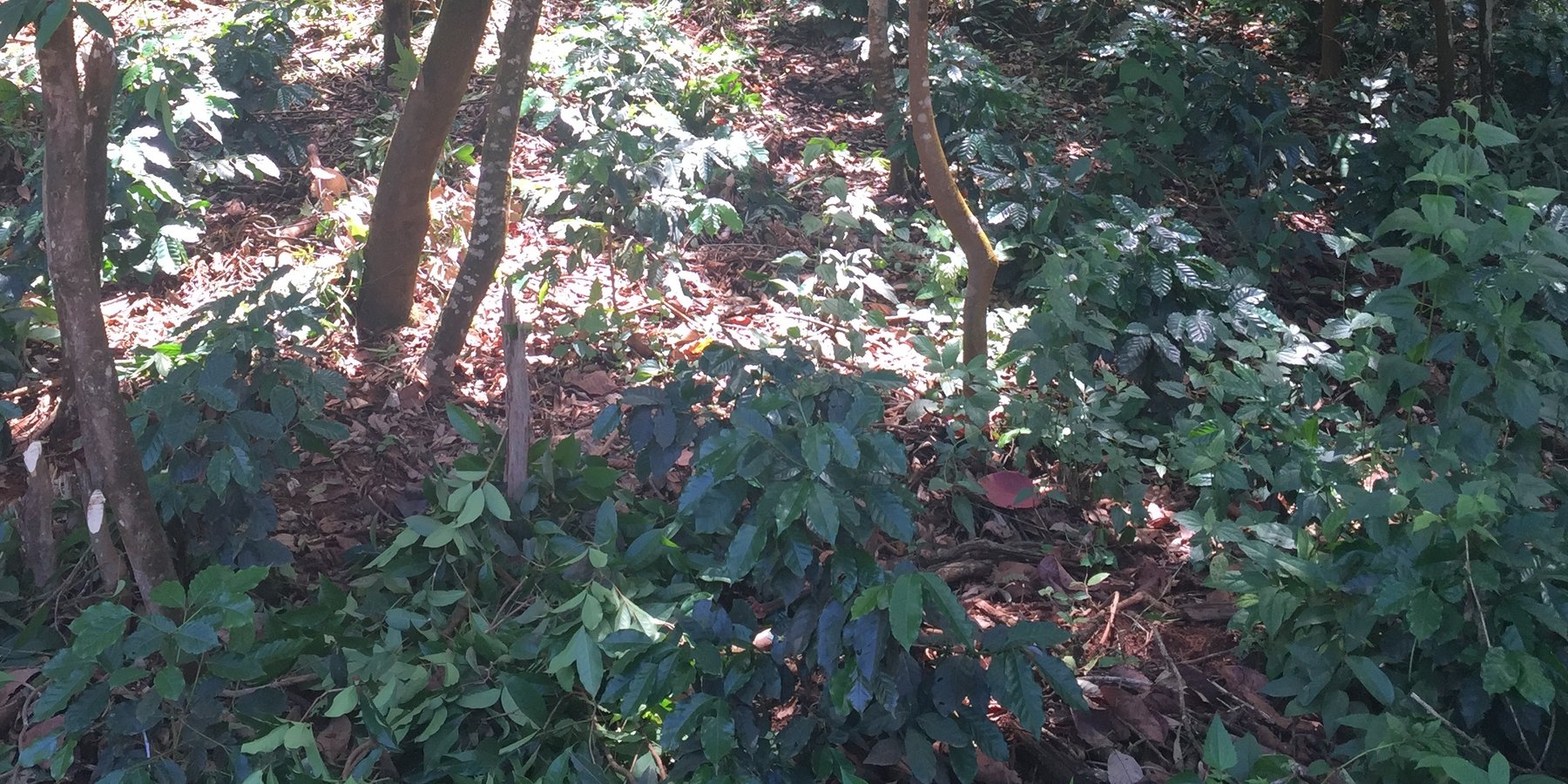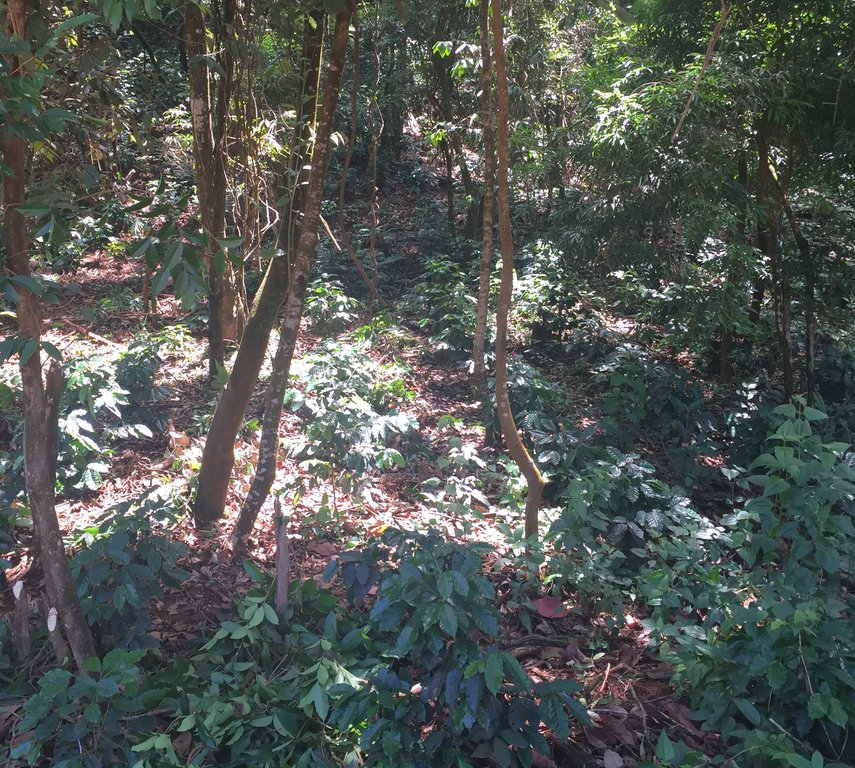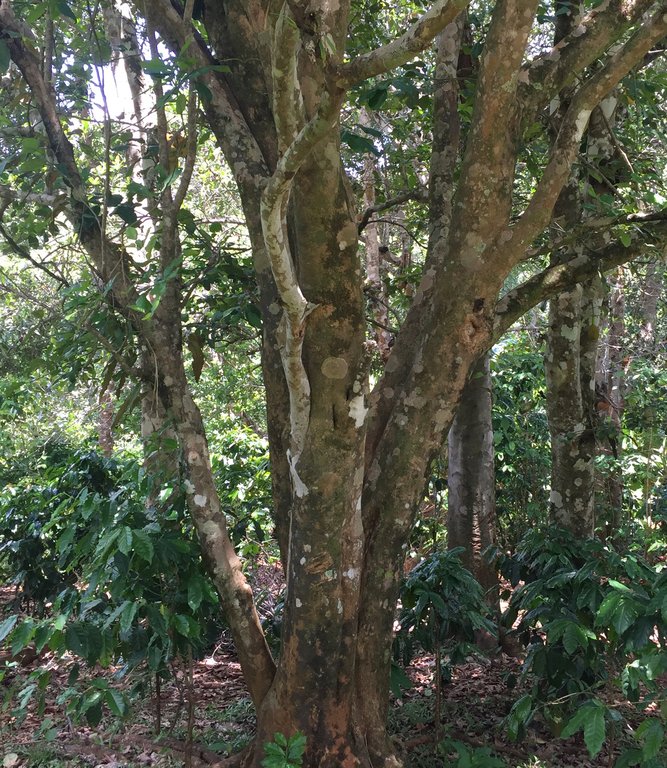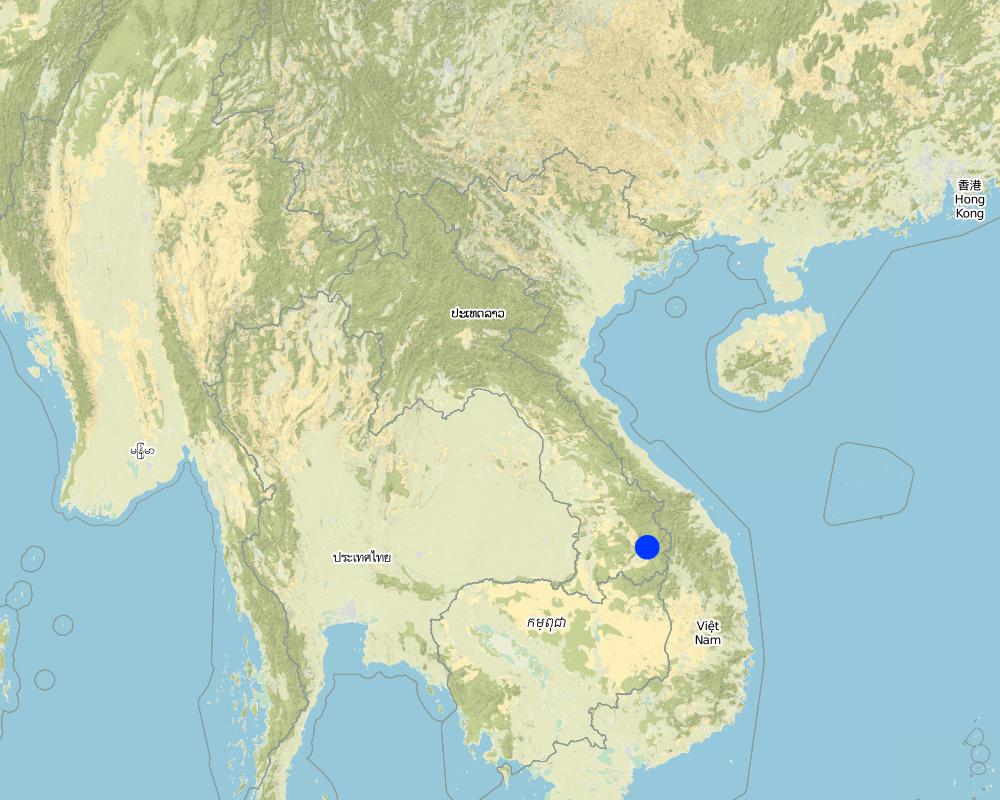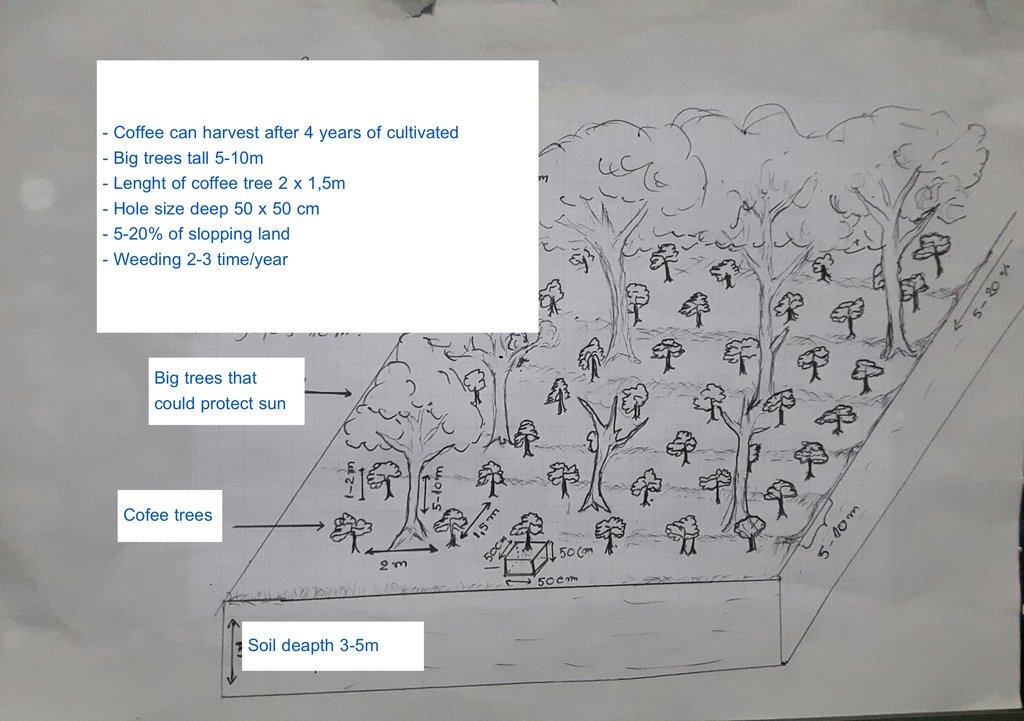Coffee cultivation between big trees in sloping fallows [Lao People's Democratic Republic]
- Creation:
- Update:
- Compiler: Vongsackda Duangvilay
- Editor: Bounthanom Bouahom
- Reviewers: Nicole Harari, Stephanie Jaquet, Alexandra Gavilano
technologies_2688 - Lao People's Democratic Republic
View sections
Expand all Collapse all1. General information
1.2 Contact details of resource persons and institutions involved in the assessment and documentation of the Technology
Key resource person(s)
land user:
Bouathong
Lao People's Democratic Republic
Name of project which facilitated the documentation/ evaluation of the Technology (if relevant)
Scaling-up SLM practices by smallholder farmers (IFAD)Name of the institution(s) which facilitated the documentation/ evaluation of the Technology (if relevant)
National Agriculture and Forestry Research Institute (NAFRI) - Lao People's Democratic Republic1.3 Conditions regarding the use of data documented through WOCAT
The compiler and key resource person(s) accept the conditions regarding the use of data documented through WOCAT:
Yes
1.4 Declaration on sustainability of the described Technology
Is the Technology described here problematic with regard to land degradation, so that it cannot be declared a sustainable land management technology?
No
2. Description of the SLM Technology
2.1 Short description of the Technology
Definition of the Technology:
Coffee plants cultivated between big trees in sloping fallows for income generation as well as maintaining biodiversity and increased forest cover.
2.2 Detailed description of the Technology
Description:
Since 1980 a number of villagers worked on coffee plantations in Paksong District, Bolaven Plateau of Champasack Province. Thus, they learnt how to cultivate coffee and brought their knowledge to their villages due to suitable natural conditions there. Temperature suitable for coffee there ranges from 15 – 25°C and pH levels of soils between 5.5 and 6.5, average rainfall between 1000-1500 mm/year, and altitude of approximately 800 m.a.s.l. Subsequently, small coffee plantations were observed all over the region, but failed soon because the villagers planted coffee intercropped with upland rice within their traditional extensive slash and burn practice. One of the reasons of very low coffee yields was the lacking shadow and the inconsistent humidity during dry season.
In 2009, a project supported by IFAD promoted coffee cultivated between big trees as a trial to villagers in Paksong District. But the selection of “Mai Thorng” (Erythrina stricta Roxburgh) - a type of savannah tree that provides enough shade to coffee plants - unfortunately was not successful as well, as it was not adapted to the local climate. Therefore, in 2012, Mr. Bouathong in Chalurnxay village, Xanay district of Attapue province tried to use locally grown trees which provide adequate shade to the coffee plants. They started to clear carefully fallow fields from vegetation whilst preserving bigger trees (age of fallow 5- 10 years and older). This included most of the trees older than 5 years. The clearance has to be conducted in January by removing smaller trees and shrubs. However, it is important that the remaining trees do not create to excessive shadow, as coffee plant needs approximately 50-60 percent of sunlight to grow well. The space between the seedlings is 3 x 3 or 4 x 3 meters. The size of the planting holes is 50x50x50cm. Before planting of coffee seedlings organic manure has to be filled in the hole to improve soil fertility (5kg/hole). To establish such kind of coffee plantation following inputs are needed: coffee seedlings, sunlight protection sheets, watering pot, fork, plastic bags for the seedlings, and organic fertilizer. The most important input is the labour for selective clearance, land preparation, and fencing (around 5 to 10 workers for 1 ha). From the very beginning a wooden fence out of timber from previously cleared small trees has to be installed for getting protection against livestock damages. Also weeding (3-4 times a year) and thinning of tree branches is required. The decayed plant material can be used as soil cover to increase natural soil nutrients and to control storm water from run-off.
Outcomes from this method indicated that coffee plants grow successfully with healthy stems and suckers, and dark green leaves. And coffee plant survival rate of 80 percent was far higher compared to the rate of only 50% in former plantations without trees. Three years after planting coffee plants produces coffee beans.
Coffee now is playing an important role for the local land users regarding revenue generation. The coffee prices in mountainous areas of Xanxay District vary depending on species and range from 5,000 to 8000Kip/kg for fresh coffee beans; 12,000 to 16000Kip/kg for threshed coffee beans (average annual income 5,000,000Kip / household). Estimated production of fresh beans is between 4,000-5,000Kg/ha. Yields significantly increase compared to old plantations that provided only 500-800Kg/ha.
Purpose and advantage of this technology include the use of fallow and degraded forest areas to the benefit of local land users such us improved land use rights and reduction of land conflicts because of stabilization of shifting cultivation. People are required to find animal manure to fertilize the coffee plant, but they can also use coffee bean husk as green compost around the coffee plant, as this promotes soil nutrients, soil organisms (e.g. earthworms), and it keeps soil moisture and increases soil porosity. Benefits of this agroforestry that reduction of slash and burn practice. The coffee cultivation in a agroforsestry system as permanent land use practices reduces pressure on forest land, increases the forest canopy, preserve bigger trees as habitat for local animals, and promotes higher plant diversity. Furthermore, people can collect local mushrooms and other edible plants/vegetables such as Phak Varn, Phak Koum, rattan shoots, ferns, and others.
2.3 Photos of the Technology
2.5 Country/ region/ locations where the Technology has been applied and which are covered by this assessment
Country:
Lao People's Democratic Republic
Region/ State/ Province:
Attapue province
Further specification of location:
Xanxay district
Specify the spread of the Technology:
- evenly spread over an area
If precise area is not known, indicate approximate area covered:
- < 0.1 km2 (10 ha)
Map
×2.6 Date of implementation
Indicate year of implementation:
2012
If precise year is not known, indicate approximate date:
- less than 10 years ago (recently)
2.7 Introduction of the Technology
Specify how the Technology was introduced:
- through land users' innovation
- through projects/ external interventions
3. Classification of the SLM Technology
3.1 Main purpose(s) of the Technology
- improve production
- conserve ecosystem
- preserve/ improve biodiversity
- create beneficial economic impact
3.2 Current land use type(s) where the Technology is applied
Land use mixed within the same land unit:
Yes
Specify mixed land use (crops/ grazing/ trees):
- Agroforestry

Cropland
- Tree and shrub cropping
Tree and shrub cropping - Specify crops:
- coffee, shade grown
Number of growing seasons per year:
- 1

Forest/ woodlands
- (Semi-)natural forests/ woodlands
(Semi-)natural forests/ woodlands: Specify management type:
- Selective felling
3.4 Water supply
Water supply for the land on which the Technology is applied:
- rainfed
3.5 SLM group to which the Technology belongs
- agroforestry
3.6 SLM measures comprising the Technology

management measures
- M1: Change of land use type
3.7 Main types of land degradation addressed by the Technology

biological degradation
- Bc: reduction of vegetation cover
- Bh: loss of habitats
- Bs: quality and species composition/ diversity decline
3.8 Prevention, reduction, or restoration of land degradation
Specify the goal of the Technology with regard to land degradation:
- prevent land degradation
4. Technical specifications, implementation activities, inputs, and costs
4.1 Technical drawing of the Technology
Technical specifications (related to technical drawing):
1. First, the local land users need to select sites in fallow forest areas where big trees still remain through observation on the land use history. The old fallow
forest may range from 5-10 years and above. Clear first the shrubs and bushes and retain approximately 50% of the vegetation. 2. The vegetation clearance can begin with removing small trees (wherever easy to start with) and preserve
some of the big trees (5 years old and over). 3. After clearing all small trees, observe the bigger trees with approximate 5-10m height whether it requires thinning and further clearance around the retention trees to allow some sunlight reaching coffee plants understory. 4. It is not necessary to burn spoiled vegetation after clearance. Instead, suitable logs shall be used for fence construction whilst other grasses and weeds can be used to cover grounds for soil improvement. 5. After completion of vegetation clearance and land preparation, farmers can plant coffees seedlings appropriate to site conditions. 6. Weeding is required for coffee plantation and about 3 – 4 times a year until coffee seedlings are mature (weeding may not require after third years of planting). Farmers also need to conduct regular thinning of big trees to ensure sunlight reaches the coffee plants. 7. After completion of each weeding and thinning activities, farmers are recommended to collect decaying vegetation to cover the ground of coffee plantation as a mean to increase natural soil nutrients and control storm water run-off.
Author:
Vongsackda Khounyasay
Date:
20/05/2017
4.2 General information regarding the calculation of inputs and costs
Specify how costs and inputs were calculated:
- per Technology area
Indicate size and area unit:
1,5
If using a local area unit, indicate conversion factor to one hectare (e.g. 1 ha = 2.47 acres): 1 ha =:
Hactare
other/ national currency (specify):
LAK
If relevant, indicate exchange rate from USD to local currency (e.g. 1 USD = 79.9 Brazilian Real): 1 USD =:
8000.0
Indicate average wage cost of hired labour per day:
20000
4.3 Establishment activities
| Activity | Timing (season) | |
|---|---|---|
| 1. | Seedling preparation | Begining of November |
| 2. | Nursery preparation for seedlings, fencing, net and other inputs for seedlings | November to December |
| 3. | Seedling maintenance | |
| 4. | Land preparation for planting | |
| 5. | Dig hole | |
| 6. | Planting |
4.4 Costs and inputs needed for establishment
| Specify input | Unit | Quantity | Costs per Unit | Total costs per input | % of costs borne by land users | |
|---|---|---|---|---|---|---|
| Labour | Labour for selective clearing of fallow and land preparation | person day | 18.0 | 20000.0 | 360000.0 | 100.0 |
| Labour | Labour for seedlings preparation | person day | 1.0 | 20000.0 | 20000.0 | 100.0 |
| Labour | Labour for putting soil and seedlings into plastic bag | person day | 32.0 | 20000.0 | 640000.0 | 100.0 |
| Labour | Labour for fencing | person day | 16.0 | 20000.0 | 320000.0 | 100.0 |
| Equipment | Big knief | piece | 4.0 | 15000.0 | 60000.0 | 100.0 |
| Equipment | Shovel | piece | 4.0 | 50000.0 | 200000.0 | 100.0 |
| Plant material | Seedlings | seed | 30.0 | 1000.0 | 30000.0 | 100.0 |
| Fertilizers and biocides | Manure | kg | 50.0 | 5000.0 | 250000.0 | 100.0 |
| Construction material | Sunlight protection sheet | Metre | 10.0 | 10000.0 | 100000.0 | 100.0 |
| Construction material | Plastic bag for seed | bag | 100.0 | 500.0 | 50000.0 | 100.0 |
| Other | Labour for planting the seedlings | person day | 12.0 | 20000.0 | 240000.0 | 100.0 |
| Total costs for establishment of the Technology | 2270000.0 | |||||
| Total costs for establishment of the Technology in USD | 283.75 | |||||
4.5 Maintenance/ recurrent activities
| Activity | Timing/ frequency | |
|---|---|---|
| 1. | Weeding | 2-3 time/year |
| 2. | Maintenance the fence |
4.6 Costs and inputs needed for maintenance/ recurrent activities (per year)
| Specify input | Unit | Quantity | Costs per Unit | Total costs per input | % of costs borne by land users | |
|---|---|---|---|---|---|---|
| Labour | Labour for weeding | person day | 3.0 | 20000.0 | 60000.0 | 100.0 |
| Labour | Labour for maintenance of the fence | person day | 4.0 | 20000.0 | 80000.0 | 100.0 |
| Labour | Labour for bring the manure | person day | 2.0 | 20000.0 | 40000.0 | 100.0 |
| Total costs for maintenance of the Technology | 180000.0 | |||||
| Total costs for maintenance of the Technology in USD | 22.5 | |||||
4.7 Most important factors affecting the costs
Describe the most determinate factors affecting the costs:
The most important factor affecting cost is labour for selective clearance.
5. Natural and human environment
5.1 Climate
Annual rainfall
- < 250 mm
- 251-500 mm
- 501-750 mm
- 751-1,000 mm
- 1,001-1,500 mm
- 1,501-2,000 mm
- 2,001-3,000 mm
- 3,001-4,000 mm
- > 4,000 mm
Agro-climatic zone
- sub-humid
5.2 Topography
Slopes on average:
- flat (0-2%)
- gentle (3-5%)
- moderate (6-10%)
- rolling (11-15%)
- hilly (16-30%)
- steep (31-60%)
- very steep (>60%)
Landforms:
- plateau/plains
- ridges
- mountain slopes
- hill slopes
- footslopes
- valley floors
Altitudinal zone:
- 0-100 m a.s.l.
- 101-500 m a.s.l.
- 501-1,000 m a.s.l.
- 1,001-1,500 m a.s.l.
- 1,501-2,000 m a.s.l.
- 2,001-2,500 m a.s.l.
- 2,501-3,000 m a.s.l.
- 3,001-4,000 m a.s.l.
- > 4,000 m a.s.l.
Indicate if the Technology is specifically applied in:
- not relevant
5.3 Soils
Soil depth on average:
- very shallow (0-20 cm)
- shallow (21-50 cm)
- moderately deep (51-80 cm)
- deep (81-120 cm)
- very deep (> 120 cm)
Soil texture (topsoil):
- medium (loamy, silty)
Soil texture (> 20 cm below surface):
- medium (loamy, silty)
Topsoil organic matter:
- medium (1-3%)
5.4 Water availability and quality
Ground water table:
5-50 m
Availability of surface water:
medium
Water quality (untreated):
poor drinking water (treatment required)
Is water salinity a problem?
No
Is flooding of the area occurring?
No
5.5 Biodiversity
Species diversity:
- medium
Habitat diversity:
- medium
5.6 Characteristics of land users applying the Technology
Sedentary or nomadic:
- Sedentary
Market orientation of production system:
- commercial/ market
Off-farm income:
- 10-50% of all income
Relative level of wealth:
- average
Individuals or groups:
- individual/ household
Level of mechanization:
- manual work
Gender:
- men
Age of land users:
- middle-aged
5.7 Average area of land used by land users applying the Technology
- < 0.5 ha
- 0.5-1 ha
- 1-2 ha
- 2-5 ha
- 5-15 ha
- 15-50 ha
- 50-100 ha
- 100-500 ha
- 500-1,000 ha
- 1,000-10,000 ha
- > 10,000 ha
Is this considered small-, medium- or large-scale (referring to local context)?
- large-scale
5.8 Land ownership, land use rights, and water use rights
Land ownership:
- individual, titled
Land use rights:
- individual
Water use rights:
- open access (unorganized)
5.9 Access to services and infrastructure
health:
- poor
- moderate
- good
education:
- poor
- moderate
- good
technical assistance:
- poor
- moderate
- good
employment (e.g. off-farm):
- poor
- moderate
- good
markets:
- poor
- moderate
- good
energy:
- poor
- moderate
- good
roads and transport:
- poor
- moderate
- good
drinking water and sanitation:
- poor
- moderate
- good
financial services:
- poor
- moderate
- good
6. Impacts and concluding statements
6.1 On-site impacts the Technology has shown
Socio-economic impacts
Production
crop production
Quantity before SLM:
Coffee production 500-800 kg/ha
Quantity after SLM:
Coffee production 4000-5000 kg/ha
crop quality
Comments/ specify:
Increased both productivity and quality
forest/ woodland quality
Comments/ specify:
Under former slash and burn technique the whole vegetation was cleared, now big trees are saved and forest cover has been improved.
non-wood forest production
Comments/ specify:
Apart from coffee beans, now mushrooms, Phak Varn, Phak Koum, rattan shoots, ferns are available in the agroforestry area.
Income and costs
farm income
Comments/ specify:
Increased income from coffee (5 million LAK/year).
workload
Comments/ specify:
Decreased labour due to reduction of shifting cultivation.
Socio-cultural impacts
land use/ water rights
Comments/ specify:
Under this technique the land user own the plantation area legally.
conflict mitigation
Comments/ specify:
Reduction of land conflict because of stabilize shifting cultivation legalization of land use rights.
Ecological impacts
Soil
soil moisture
Comments/ specify:
The land user uses the dry grase/leaves for mulching to improve soil moisture.
soil compaction
Quantity before SLM:
ຖາງປ່າເຮັດໄຮ່ ແບບໝູນວຽນ ໄລຍະອາຍຸ ຂອງປ່າເລົ່າສັ້ນ
Quantity after SLM:
ຫຼຸດຜ່ອນ ການຖາງ ປ່າເຮັດໄຮ່ ແບບເລື່ອນລອຍ
Biodiversity: vegetation, animals
Vegetation cover
Comments/ specify:
Increase in tree canopy as well as increase in forest cover.
plant diversity
Comments/ specify:
Increase of local mushroom and wide vegetables for food consumption.
Climate and disaster risk reduction
emission of carbon and greenhouse gases
Comments/ specify:
Due to the reduction in slash and burn cultivation, forest cover increased and in consequence, more greenhouse gases were assimilated and furthermore, the reduction in fires has decreased the emission of greenhouse gases.
6.2 Off-site impacts the Technology has shown
impact of greenhouse gases
Comments/ specify:
Due to the reduction in slash and burn cultivation, forest cover increased and in consequence, more greenhouse gases were assimilated and furthermore, the reduction in fires has decreased the emission of greenhouse gases.
6.3 Exposure and sensitivity of the Technology to gradual climate change and climate-related extremes/ disasters (as perceived by land users)
Gradual climate change
Gradual climate change
| Season | increase or decrease | How does the Technology cope with it? | |
|---|---|---|---|
| seasonal rainfall | wet/ rainy season | decrease | very well |
6.4 Cost-benefit analysis
How do the benefits compare with the establishment costs (from land users’ perspective)?
Short-term returns:
slightly negative
Long-term returns:
positive
How do the benefits compare with the maintenance/ recurrent costs (from land users' perspective)?
Short-term returns:
slightly negative
Long-term returns:
positive
6.5 Adoption of the Technology
- > 50%
Of all those who have adopted the Technology, how many did so spontaneously, i.e. without receiving any material incentives/ payments?
- 91-100%
6.6 Adaptation
Has the Technology been modified recently to adapt to changing conditions?
No
6.7 Strengths/ advantages/ opportunities of the Technology
| Strengths/ advantages/ opportunities in the land user’s view |
|---|
| Unnecessary to slash and burn clearance as bigger trees have to be retained. |
| The coffee plantation can protect the environment and forest. |
| Farmers can sell their coffee that generate good household income. |
| Strengths/ advantages/ opportunities in the compiler’s or other key resource person’s view |
|---|
| Ecosystem sustainability and increased biodiversity. |
| Increase in forest cover and stabilization of shifting cultivation. |
| Reduced encroachment in agricultural lands of other local land users. |
6.8 Weaknesses/ disadvantages/ risks of the Technology and ways of overcoming them
| Weaknesses/ disadvantages/ risks in the land user’s view | How can they be overcome? |
|---|---|
| The local land users still lack knowledge and skills to estimate necessary amount of retaining vegetation or big trees which is different to complete clearance and burning. | The need to engage skilled labour to provide advice during land preparation. |
| Some coffee plantations are not maintained effectively enough. This promote bush and shrub growth and in consequence impede harvest of coffee beans. | Therefore, the weeding requires intensive labours prior to coffee collection. |
| Weaknesses/ disadvantages/ risks in the compiler’s or other key resource person’s view | How can they be overcome? |
|---|---|
| There are no rules or standard operating procedures regarding the selective clearance and retention of vegetation and trees. | It needs advices from local expert who have skill to estimate on the number of trees to be maintained. |
| Most of the local land users select now land to grow coffee in slope areas where the land is limited. | It is most suitable if local land users can establish coffee plantation near streams due to fertile soil with suitable climate. |
7. References and links
7.1 Methods/ sources of information
- field visits, field surveys
1
- interviews with land users
1
When were the data compiled (in the field)?
17/05/2017
Links and modules
Expand all Collapse allLinks
No links
Modules
No modules


